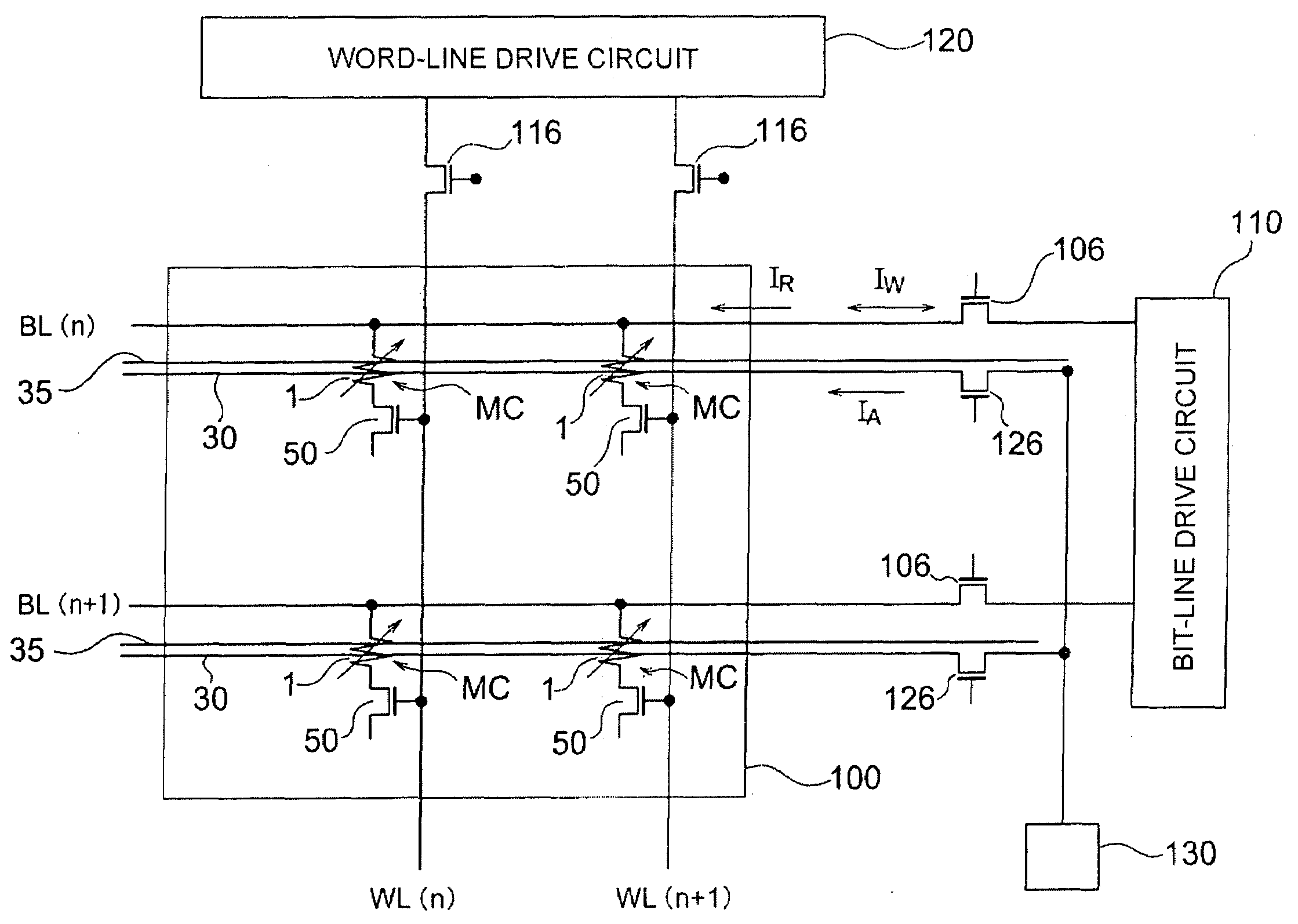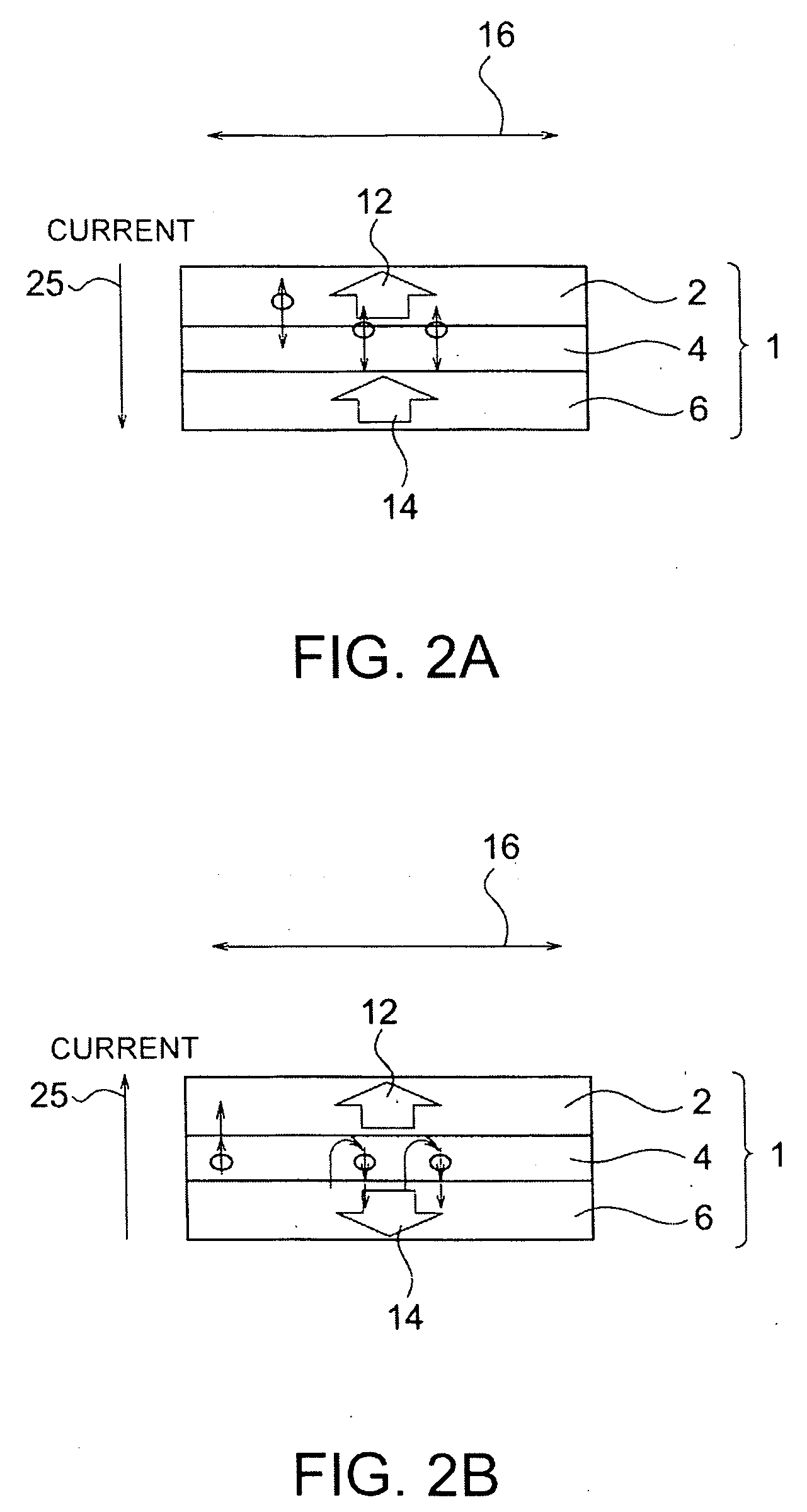Magnetic memory
a magnetic memory and memory technology, applied in the field of magnetic memory, can solve the problems of insufficient magnetic fields, difficult localization of magnetic fields, and inability to generate sufficient magnetic fields, so as to reduce the variations of spin-polarized current, reduce the reversal current, and reduce the effect of reversal curren
- Summary
- Abstract
- Description
- Claims
- Application Information
AI Technical Summary
Benefits of technology
Problems solved by technology
Method used
Image
Examples
first embodiment
[0029]FIG. 1 is a schematic view showing a sectional structure of a magnetic memory according to a first embodiment of the invention. The magnetic memory of the embodiment is provided with a plurality of memory cells arrayed in a matrix and each cell is provided with a magnetic recording element 1, an interconnection 30 to generate a radio-frequency current-induced magnetic field, a ground line 35, an extraction electrode 40, a connecting plug 45 and a switching element 50. The interconnection to generate a radio-frequency current-induced magnetic field will be referred to as the “RF interconnection” hereinafter.
[0030]The magnetic recording element 1 is a magnetoresistive effect element and has a layered structure with a first magnetic layer 2, a first nonmagnetic layer 4, and a magnetic recording layer 6 laminated in this order. The first magnetic layer, the first nonmagnetic layer, the magnetic recording layer are referred to as the magnetic fixed layer, the nonmagnetic barrier la...
example
[0098]This embodiment will be explained more in detail with reference to an example.
[0099]In the example, the magnetic memory with the same structure as shown in FIG. 1 has been actually made (the sample number S1). The magnetic recording element of the magnetic memory is provided with the following materials and layer thicknesses. First, the magnetic fixed layer 2 is formed on the antiferromagnetic layer (not shown) consisting essentially of IrMn, and has the layered structure comprising a 1-nm thick CoFeB film / a 1-nm thick Ru film / a 4-nm thick CoFe film. The nonmagnetic barrier layer 4 comprises a 1 nm-thick MgO film. The magnetic recording layer 6 has the layered structure of a 1 nm-thick CoFe film and a 1 nm-thick CoFeB film. A CoFe film is provided at the side of the nonmagnetic barrier layer 4. The RF interconnection 30 is provided across a 0.06 μm-thick SiO2 layer above the bit line 20. The RF interconnection 30 comprises a 1-μm thick gold, and its cross-section measures 1 μm...
first modified example
[0109]FIG. 12 shows a connection diagram of a magnetic memory according to the first modified example of the embodiment. The magnetic memory of the modified example is provided with a memory cell array 100 where a plurality of memory cells MC are arrayed in a matrix. Each memory cell MC is provided with a magnetic recording element 1 and a switching element 50 comprising an MOS transistor connected to the element 1 in series. A terminal of the magnetic recording element 1 of the memory cell MC located on the same row of the matrix is connected to the same bit line BL. Each bit line BL is connected to a bit-line drive circuit 110 via a selection element 106. In the memory cell array 100, the gate of the switching element 50 of the memory cell MC located on the same column of the matrix is connected to the same word line WL. Each word line WL is connected to a word-line drive circuit 120 via a selection element 116. And further, an RF interconnection 30 is provided in parallel to each...
PUM
| Property | Measurement | Unit |
|---|---|---|
| frequency | aaaaa | aaaaa |
| magnetization | aaaaa | aaaaa |
| nonmagnetic | aaaaa | aaaaa |
Abstract
Description
Claims
Application Information
 Login to View More
Login to View More - R&D
- Intellectual Property
- Life Sciences
- Materials
- Tech Scout
- Unparalleled Data Quality
- Higher Quality Content
- 60% Fewer Hallucinations
Browse by: Latest US Patents, China's latest patents, Technical Efficacy Thesaurus, Application Domain, Technology Topic, Popular Technical Reports.
© 2025 PatSnap. All rights reserved.Legal|Privacy policy|Modern Slavery Act Transparency Statement|Sitemap|About US| Contact US: help@patsnap.com



